The Automatic Goat Waterer Market is estimated to be valued at USD 326.0 billion in 2025 and is projected to reach USD 546.4 billion by 2035, registering a compound annual growth rate (CAGR) of 5.3% over the forecast period.
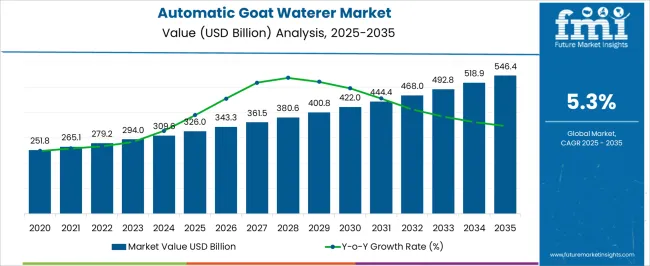
| Metric | Value |
|---|---|
| Automatic Goat Waterer Market Estimated Value in (2025 E) | USD 326.0 billion |
| Automatic Goat Waterer Market Forecast Value in (2035 F) | USD 546.4 billion |
| Forecast CAGR (2025 to 2035) | 5.3% |
The automatic goat waterer market is experiencing consistent expansion driven by the need for efficient livestock hydration systems, rising emphasis on animal welfare, and increasing adoption of automated farming practices. Farmers are focusing on reducing manual labor while ensuring consistent water supply that supports animal health and productivity.
Advancements in durable materials, energy efficient mechanisms, and frost resistant designs are improving product reliability and long term cost effectiveness. Regulatory focus on livestock care standards and increasing awareness of sustainable farming practices are further encouraging adoption.
The outlook remains positive as modern farms prioritize automation and resource optimization, leading to increased integration of smart hydration systems in both small and large scale farming operations.
The market is segmented by Material and Application and region. By Material, the market is divided into Plastic, Steel, and Cast Iron. In terms of Application, the market is classified into Small Farm and Large Farm. Regionally, the market is classified into North America, Latin America, Western Europe, Eastern Europe, Balkan & Baltic Countries, Russia & Belarus, Central Asia, East Asia, South Asia & Pacific, and the Middle East & Africa.
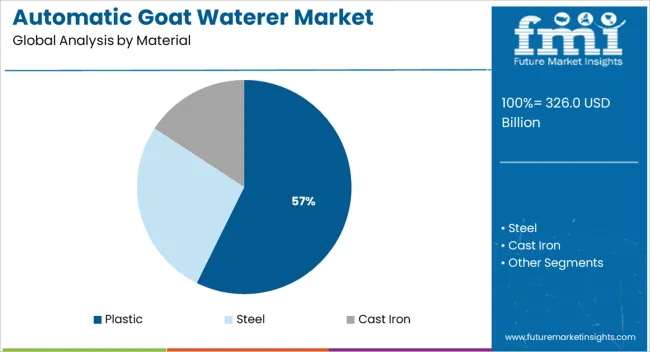
The plastic material segment is expected to account for 57.30% of the total market revenue by 2025, positioning it as the leading material choice. Its dominance is attributed to lightweight construction, cost effectiveness, and resistance to rust and corrosion compared to metal alternatives.
Plastic waterers are easier to install, clean, and maintain, which makes them highly suitable for daily farm operations. The material’s adaptability allows manufacturers to design durable, frost resistant, and UV stable products that ensure consistent performance in varying climates.
As farmers seek affordable yet long lasting solutions, plastic continues to be the preferred material for automatic goat waterers.
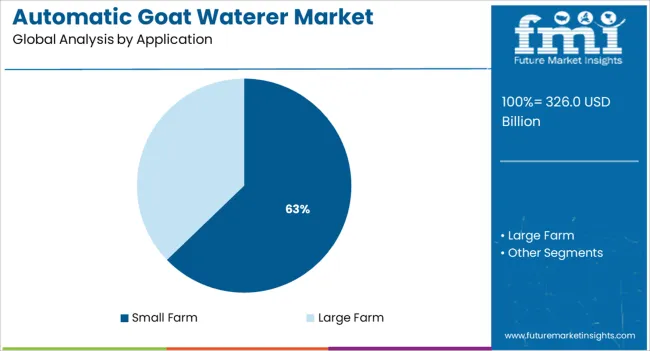
The small farm application segment is projected to hold 62.80% of the overall market revenue by 2025, making it the most prominent application category. This leadership is driven by the growing number of small scale farms adopting cost effective automation solutions to improve livestock care.
Small farms benefit significantly from automatic goat waterers as they reduce daily labor requirements and ensure animals have constant access to clean water. Increased awareness of animal health management and productivity enhancement has further supported adoption.
The affordability and ease of installation of these systems make them especially attractive to small farm owners, ensuring their continued dominance in the application segment.
When compared to the 4.7% CAGR recorded between 2020 and 2025, the automatic goat waterer market is predicted to expand at a 5.3% CAGR between 2025 and 2035.
| 2020 | USD 211.4 million |
|---|---|
| 2024 | USD 266.6 million |
| 2025 | USD 279.2 million |
| 2025 | USD 294 million |
| 2035 | USD 546.4 million |
With the increase in the global population, demand for meat and dairy products including cream, butter, and cheese is expected to increase dramatically. This necessitates the need for more advanced livestock management amenities and facilities. Innovation and the increasing usage of livestock farming equipment are two key factors anticipated to drive the future growth of this market.
| Short Term (2025 to 2029) | The market is expected to grow as an outcome of high technological investments, and rising consumer demand for dairy products of superior quality and productivity optimization. |
|---|---|
| Medium Term (2029 to 2035) | Sales of goat farming equipment are projected to rise owing to the manufacturers' growing desire for automated manufacturing operations across several industries. This is expected to propel the market expansion ultimately |
| Long Term (2035 to 2035) | The sale of livestock farming equipment through online stores has significantly increased during the last few years. E-commerce is expected to be crucial in enhancing access to reasonably priced automatic goat waterers. |
These factors are anticipated to support a 1.7X increase in the automatic goat waterer market between 2025 and 2035. The market is projected to be worth USD 546.4 million by the end of 2035, according to FMI analysts.
The global market is anticipated to expand over the forecast period as a result of several relevant variables that have been observed. Along with the market's growth factors, FMI researchers also looked at potential threats, attractive opportunities, and restricting factors that can have an impact on sales of automatic goat waterers.
| Drivers |
|
|---|---|
| Restraints |
|
| Opportunities |
|
| Threats |
|
In 2025, the steel segment was the market leader. Owing to this segment's remarkable qualities, including strength, durability, and corrosion resistance, it is projected that there would be a significant demand for it. Additionally, automatic steel goat waterers can be customized to meet the unique requirements of a farm also contribute to rising demand.
The best and safest material for a goat farming equipment system is steel. It is hygienic since it is easily cleaned with water and soap meaning that no bacteria can develop on its surface. It is lighter than cast iron and more robust than plastic. Steel automatic goat waterers are becoming more well-liked since they are resilient and convenient.
Effective machinery is necessary for large farms to satisfy the rising demand for goat products including milk, meat, and wool. With the use of automatic goat waterers, large farms can reduce labor costs and physical labor to a certain extent. Due to the special care and housing requirements of goats, large farm owners favor these automated waterers in particular.
The large farms must be well maintained if they are to produce as much as possible. The utilization of automated waterers can simplify farm operations and enhance goat management. Due to the rising demand for goat byproducts, large farms utilize water resources to ensure the hygienic manufacture of their products. The large farm market segment is likely to grow as a result.
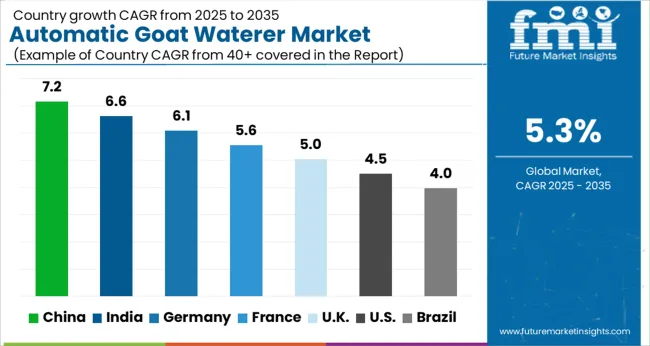
| Country | United States of America |
|---|---|
| Market Share (2025) | 30.2% |
| Market Value (2025) | USD 84.4 million |
| Country | Germany |
|---|---|
| Market Share (2025) | 16.1% |
| Market Value (2025) | USD 44.9 million |
| Country | United Kingdom |
|---|---|
| Market Share (2025) | 9.5% |
| Market Value (2025) | USD 26.5 million |
| Country | China |
|---|---|
| Market Share (2025) | 10.3% |
| Market Value (2025) | USD 28.77 million |
| Country | Japan |
|---|---|
| Market Share (2025) | 3.8% |
| Market Value (2025) | USD 10.7 million |
| Country | India |
|---|---|
| Market Share (2025) | 4.2% |
| Market Value (2025) | USD 11.7 million |
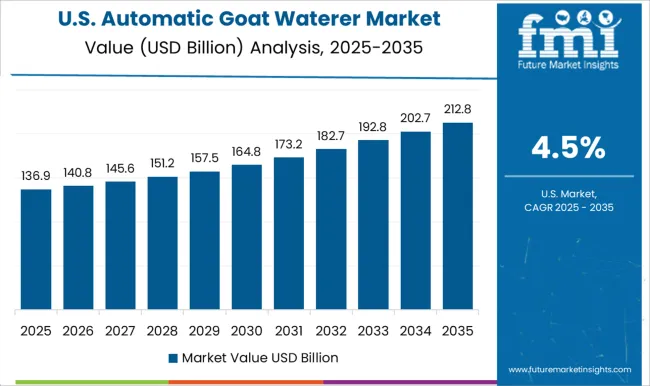
Since goats are effective at converting subpar forages into high-quality meat, milk, and skins for niche markets, goat farming has expanded by about one-third in the USA. All United States cities cultivate breeds of meat goats. The popularity of goats is rising for a variety of reasons in this nation. The majority of ethnic groups that have immigrated to the USA are the leading contributing element.
Over 80% of the goats produced in the USA are meat goats, according to the National Agricultural Statistics Service (NASS). Goat farming is preferred by rural farms since it has fewer risks than other animal production endeavors. The USA also has a sizable and diversified population of goats, which contributes to the country's prominence in the automatic goat waterer business. Increased consumer demand for goat meat and dairy products, as well as growing interest in small-scale and amateur farming, are factors propelling the expansion of the USA automatic goat waterer market.
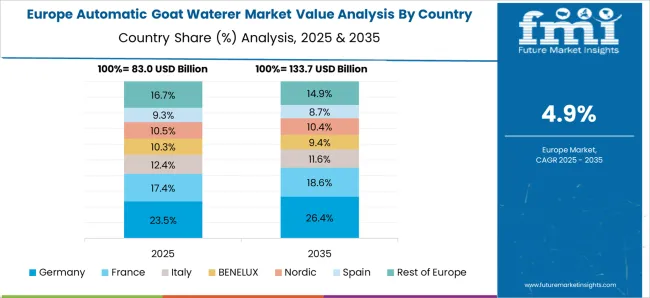
Germany is renowned for its effective and cutting-edge agricultural industry. The nation has a sizable population of farmers who raise goats for their meat and milk. The market in Germany is expanding as a result of the rising demand for specialized and organic goat products. The German government is also assisting farmers by giving them subsidies and other benefits. This is anticipated to fuel the market expansion in the nation.
In order to ensure product quality and safety, the government and the business sector are under pressure. German automatic goat waterer market is anticipated to develop because of the extensive adoption of cutting-edge technologies. The country also has a persistent need to reduce the cost of livestock production.
The United Kingdom's automatic goat waterer market is predicted to surpass USD 546.4 million by 2035, exhibiting a CAGR of 5.7%. A significant impact on the market's expansion is also predicted from government regulations governing the surveillance of animal sickness. Thus, the adoption of automated goat waterer equipment is anticipated to be widespread in the nation. The occurrence of goat illnesses such as caseous lymphadenitis, Johne's disease, and caprine arthritis encephalitis is anticipated to increase the product demand.
By 2035, the Chinese automatic goat waterer market is expected to reach a value of USD 43.6 million, registering a CAGR of 4.2%. China's livestock industry has seen a substantial transition during the last thirty years. Both the domestic and international food supply, it has had a tremendous effect. In less than 30 years, the livestock population in China tripled.
The emergence of monogastric animals and the development of industrial livestock production techniques without access to land are largely to blame for this. Changes were influenced by demand and supply for new animal species, new technology, and government support. The primary drivers of provincial demand for automatic goat waterers are expected to be governmental regulations and interstate livestock trade rules.
On the other hand, given Japan's reputation for technological advancement, the Japanese automatic goat waterer market there is projected to expand at an upright rate. Modern technology is used by livestock producers in Japan to improve goat management operations. Additionally, due to population expansion, farmers are under enormous pressure to produce and succeed. Major players have responded by coming out with innovative ideas for enhanced automatic goat waterers as a result.
Goat waterers are becoming increasingly prevalent in India as they offer a convenient method to water goats. There is a rising demand for these products as more individuals become aware of their benefits. Several significant factors, like India's growing population and rising meat and dairy consumption, are positively affecting the industry. Additionally, the emergence of e-commerce platforms is giving firms attractive expansion opportunities. The market is also expected to be stimulated by the rising popularity of organic farming. Therefore, FMI analysts envisage that the Indian automatic goat waterer market is likely to surpass USD 21.4 million by 2035, exhibiting a CAGR of 6.2%.
The desire for animal products among customers throughout the world is expected to lead to an increase in the demand for equipment used in livestock production. Several significant competitors are participating in the extremely fragmented industry. Newcomers to the automatic goat waterer market believe that sharpening their competitive edge is crucial to succeeding in this cutthroat industry. To gain momentum in the global business, they invest huge money in research & development activities and prioritize new product releases.
Top Start-ups to Watch for:
CSM Animal Husbandry & Agri Tech - India
CSM Animal Husbandry & Agri Tech, a private limited company, is founded in Tamil Nadu, India, in 2001. It manufactures, trades, and imports a high-grade line of waterers, drinkers, feeders, ear tags, and other products. The company also delivers these items in different configurations. Owing to their longevity, exquisite finish, and sturdiness, these items are in high demand.
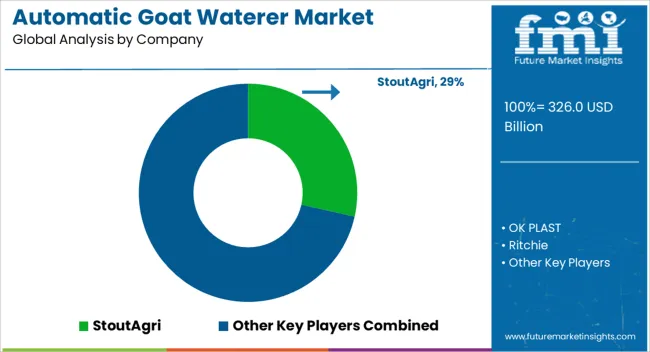
Companies that are active in the market have numerous competitive approaches at their fingertips to win over their counterparts. These techniques consist of:
Product Innovation: To draw in prospective consumers, companies introduce novel and distinctive products onto the market that use different eco-friendly materials.
Branding: Companies can distinguish themselves from competitors and foster customer loyalty by establishing a compelling brand reputation.
Distribution: Businesses can improve the marketability of their commodities by developing powerful linkages with both retailers and distributors.
Quality: Companies can establish an image for bringing the preeminent high-quality products and set themselves apart from adversaries.
Top Rated Automatic Goat Waterer Manufacturers Leading the Market
StoutAgri
StoutAgri is a company that specializes in the design, development, and production of livestock equipment. The firm produces hundreds of different items, with drinkers, feeders, automatic drinking and feeding systems, slat surface supplies, and other relevant equipment for livestock farming now making up its primary product portfolio. These products can be used on different livestock species, such as sheep, goats, cattle, pigs, and poultry.
OK PLAST
Manufacturing high-quality galvanized iron-steel buckets and ghamela was where OK Industries got its start. OK PLAST works hard to give its clients high-quality products that not only satisfy their needs but also establish a benchmark for the industry in India. The business has established itself as a market leader in the production of an extensive range of plastic goods, including buckets, tubs, milk cans, animal feeders, and waterers. The whole line of goods is produced compliant with international quality standards and guidelines utilizing high-grade plastic granules and cutting-edge molding equipment and technology.
LA BUVETTE
In the French agricultural irrigation equipment market, La Buvette is a market leader. Farmers have valued the benefits of its waterers for cattle, pigs, sheep, goats, and horses for countless generations. Given this, LA BUVETTE has come to be associated with dependability, innovation, and animal welfare.
Other Key Players Operating in the Automatic Goat Waterer Market
The global automatic goat waterer market is estimated to be valued at USD 326.0 billion in 2025.
The market size for the automatic goat waterer market is projected to reach USD 546.4 billion by 2035.
The automatic goat waterer market is expected to grow at a 5.3% CAGR between 2025 and 2035.
The key product types in automatic goat waterer market are plastic, steel and cast iron.
In terms of application, small farm segment to command 62.8% share in the automatic goat waterer market in 2025.
The global automatic goat waterer market is estimated to be valued at USD 326.0 billion in 2025.
The market size for the automatic goat waterer market is projected to reach USD 546.4 billion by 2035.
The automatic goat waterer market is expected to grow at a 5.3% CAGR between 2025 and 2035.
The key product types in automatic goat waterer market are plastic, steel and cast iron.
In terms of application, small farm segment to command 62.8% share in the automatic goat waterer market in 2025.






Full Research Suite comprises of:
Market outlook & trends analysis
Interviews & case studies
Strategic recommendations
Vendor profiles & capabilities analysis
5-year forecasts
8 regions and 60+ country-level data splits
Market segment data splits
12 months of continuous data updates
DELIVERED AS:
PDF EXCEL ONLINE
Automatic Filter Press Solutions Market Size and Share Forecast Outlook 2025 to 2035
Automatic Filter Presses (AFPs) Market Size and Share Forecast Outlook 2025 to 2035
Automatic Riveting Equipment Market Forecast and Outlook 2025 to 2035
Automatic Powder Forming Machine Market Forecast and Outlook 2025 to 2035
Automatic Weigh Price Labeling Machine Market Size and Share Forecast Outlook 2025 to 2035
Automatic Bending Machine Market Size and Share Forecast Outlook 2025 to 2035
Automatic Transmission Market Size and Share Forecast Outlook 2025 to 2035
Automatic Emergency Braking System Market Size and Share Forecast Outlook 2025 to 2035
Automatic Impact Testing Machine Market Size and Share Forecast Outlook 2025 to 2035
Automatic Glue Machine Market Size and Share Forecast Outlook 2025 to 2035
Automatic Floodgate Market Size and Share Forecast Outlook 2025 to 2035
Automatic Die Cutting Machines Market Size and Share Forecast Outlook 2025 to 2035
Automatic Dependent Surveillance-Broadcast (ADS-B) System Market Size and Share Forecast Outlook 2025 to 2035
Automatic Silver Sintering Die Attach Machine Market Size and Share Forecast Outlook 2025 to 2035
Automatic Emergency Braking (AEB) Market Size and Share Forecast Outlook 2025 to 2035
Automatic Identification and Data Capture Market Size and Share Forecast Outlook 2025 to 2035
Automatic Transfer Switch Market Size and Share Forecast Outlook 2025 to 2035
Automatic Weapons Market Size and Share Forecast Outlook 2025 to 2035
Automatic Bottle Opener Market Size and Share Forecast Outlook 2025 to 2035
Automatic Hog Feeder Market Size and Share Forecast Outlook 2025 to 2035

Thank you!
You will receive an email from our Business Development Manager. Please be sure to check your SPAM/JUNK folder too.
Chat With
MaRIA